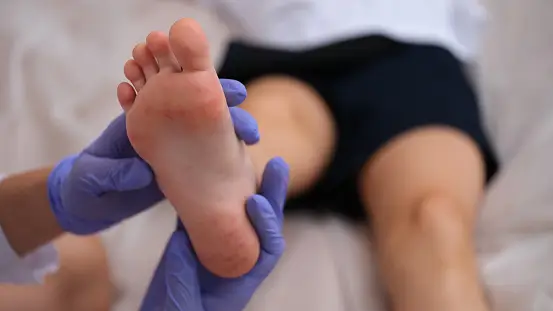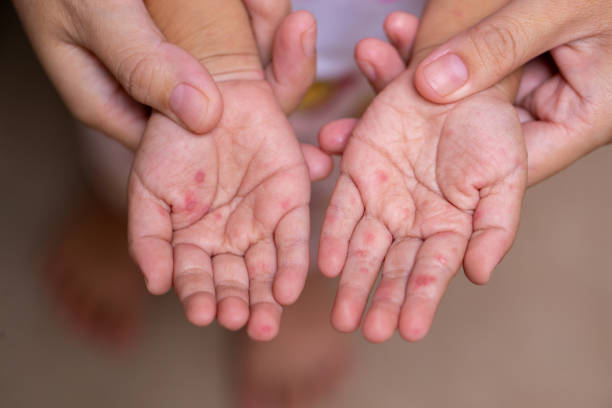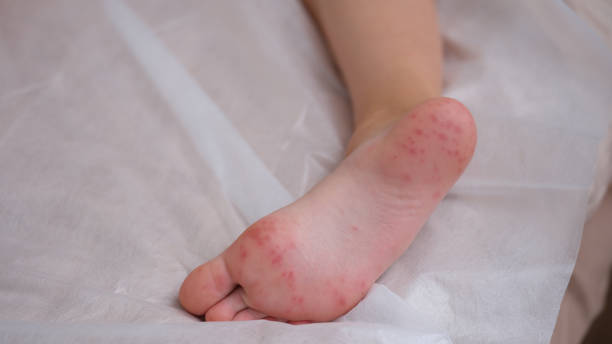Hand, Foot, and Mouth Disease (HFMD) is a common viral illness primarily affecting infants and young children, though it can also occur in adults. Characterized by a distinctive rash on the hands, feet, and mouth, this contagious condition is typically caused by enteroviruses, most commonly Coxsackievirus A16 and Enterovirus 71.
While usually mild and self-limiting, HFMD can cause discomfort and may lead to complications in some cases. Understanding its symptoms, transmission, treatment, and preventive measures is essential for managing outbreaks and ensuring effective care for those affected.
Table of Contents
Symptoms of Hand, Foot, and Mouth Disease (HFMD)

Hand, Foot, and Mouth Disease (HFMD) typically begins with mild symptoms that can escalate over a few days. It is important to recognize these signs early for timely management and to prevent spreading the infection. Here are the common symptoms associated with HFMD:
- Fever:
- HFMD often starts with a mild to moderate fever, which may precede other symptoms by 1-2 days.
- Fever can range from low-grade to high, depending on the individual’s immune response.
- Sore Throat:
- Many individuals with HFMD experience a sore throat or discomfort, especially when swallowing.
- Skin Rash:
- Hands and Feet: One of the hallmark signs is a rash that develops on the palms of the hands and the soles of the feet. This rash may appear as flat or raised red spots or small blisters.
- Buttocks and Genitalia: In some cases, the rash may also appear on the buttocks and genital area.
- Mouth Sores:
- Inside the mouth, painful sores (ulcers) may develop on the tongue, gums, and inside of the cheeks.
- These sores can be red with small white or gray centers and may make eating and drinking uncomfortable for young children.
- Loss of Appetite:
- Due to the presence of mouth sores, children may refuse to eat or drink, leading to decreased appetite and irritability.
- General Malaise:
- Children with HFMD may feel generally unwell, tired, or irritable.
- Some may experience mild abdominal discomfort or vomiting.
- Symptoms Duration:
- The symptoms of HFMD typically resolve on their own within 7-10 days.
- However, in some cases, the skin rash and mouth sores may persist longer or new symptoms such as nail shedding or temporary hair loss may occur.
Early recognition of HFMD symptoms is crucial for implementing appropriate care and preventive measures, especially in childcare settings where the infection can spread rapidly. If you suspect HFMD based on these symptoms, consulting a healthcare provider for guidance on managing the illness and preventing its spread is advisable.
Causes of Hand, Foot, and Mouth Disease (HFMD)

Hand, Foot, and Mouth Disease (HFMD) is primarily caused by several types of enteroviruses, most commonly:
- Coxsackievirus A16: This is the most frequent cause of HFMD outbreaks, responsible for a significant number of cases worldwide.
- Enterovirus 71 (EV71): Another common culprit, particularly associated with more severe cases and outbreaks.
These viruses belong to the Enterovirus genus within the Picornaviridae family. They are highly contagious and spread easily through close personal contact, respiratory droplets (coughing and sneezing), saliva, fluid from blisters, and fecal-oral transmission (ingestion of contaminated food or objects).
Transmission of HFMD:
- Direct Contact: Touching or shaking hands with someone who has HFMD.
- Indirect Contact: Touching contaminated surfaces or objects (toys, doorknobs) and then touching the face, mouth, or hands.
- Respiratory Droplets: Inhalation of airborne droplets expelled by coughing or sneezing of an infected person.
- Fecal-Oral Route: Ingestion of fecal matter, particularly in settings with poor hygiene practices, such as childcare centers.
Risk Factors:
- Age: Children under 5 years old, particularly those under 2 years, are at higher risk due to immature immune systems and frequent close contact with others in childcare settings.
- Seasonal Variation: HFMD outbreaks often peak in late summer and early fall, coinciding with increased enterovirus activity.
- Crowded Environments: Places where children gather in close quarters, such as daycare centers, preschools, and schools, facilitate rapid spread of the virus.
Understanding the causes and transmission of HFMD is essential for implementing effective preventive measures and controlling outbreaks. By practicing good hygiene and minimizing exposure to infected individuals, the spread of this common childhood illness can be reduced, leading to improved public health outcomes.
Diagnosis of Hand, Foot, and Mouth Disease (HFMD)

Diagnosing Hand, Foot, and Mouth Disease (HFMD) is primarily based on clinical presentation and history, especially during outbreaks in community settings. Healthcare providers typically rely on the following methods to diagnose HFMD:
- Clinical Evaluation:
- Symptoms Assessment: The healthcare provider examines the patient for characteristic symptoms such as fever, sore throat, skin rash on hands and feet, and mouth sores.
- Medical History: Inquiring about recent exposure to individuals with HFMD or outbreaks in the community.
- Physical Examination:
- Observation of Rash: Checking for the presence of red spots, small blisters, or ulcers on the palms of the hands, soles of the feet, and buttocks.
- Oral Examination: Looking for mouth sores or ulcers on the tongue, gums, and inside of the cheeks.
- Differential Diagnosis:
- Excluding Other Conditions: Symptoms of HFMD can resemble those of other viral infections, such as chickenpox, herpangina, and oral herpes (cold sores). Differential diagnosis may be necessary based on clinical findings and patient history.
- Laboratory Tests:
- Usually Not Required: In most cases, laboratory tests are not necessary for diagnosing typical cases of HFMD.
- Viral Culture or PCR: Rarely, a throat swab or stool sample may be collected to identify the specific enterovirus causing the infection, especially in severe or atypical cases.
- Imaging Studies:
- Not Typically Needed: Imaging studies such as X-rays or CT scans are not required for diagnosing HFMD unless complications such as pneumonia (uncommon) are suspected.
Interpretation of Results:
- Clinical Diagnosis: HFMD is primarily diagnosed based on clinical signs and symptoms. Laboratory confirmation is not routinely required unless there is uncertainty about the diagnosis or a need to monitor for specific viral strains in outbreaks.
- Differential Diagnosis: Distinguishing HFMD from other similar conditions based on clinical presentation and history helps in providing appropriate management and care.
Diagnosing Hand, Foot, and Mouth Disease (HFMD) primarily involves recognizing its characteristic symptoms and history of exposure. In most cases, clinical evaluation by a healthcare provider suffices for diagnosis, while laboratory tests are rarely needed except in severe or complicated cases. Early diagnosis allows for timely management and implementation of preventive measures to minimize the spread of the virus in community settings.
Treatment of Hand, Foot, and Mouth Disease (HFMD)

Hand, Foot, and Mouth Disease (HFMD) is typically a mild and self-limiting illness that does not require specific medical treatment in most cases. The focus of treatment is on relieving symptoms and ensuring comfort. Here are the general principles of managing HFMD:
- Symptomatic Relief:
- Fever: Use of over-the-counter fever reducers such as acetaminophen (paracetamol) or ibuprofen to reduce fever and alleviate discomfort.
- Pain Management: Oral analgesics or topical oral numbing agents (e.g., mouth sprays or gels) to relieve pain from mouth sores.
- Hydration: Encourage adequate fluid intake, especially if mouth sores make swallowing difficult. Offer cool liquids and avoid acidic or spicy foods that may irritate mouth sores.
- Comfort Measures:
- Mouth Care: Gentle oral hygiene with regular mouth rinses using saline solution or water to keep the mouth clean.
- Skin Care: Keep skin clean and dry. Avoid scratching or picking at skin blisters to prevent secondary infections.
- Rest and Recovery:
- Rest: Ensure adequate rest to support the body’s immune response and recovery.
- Isolation: During the acute phase, especially if attending daycare or school, consider keeping the child home to prevent spreading the virus to others.
- Avoid Complications:
- Monitor for Signs of Dehydration: Watch for signs of dehydration, such as decreased urine output, dry mouth, or lethargy, especially in young children.
- Seek Medical Attention: If the child experiences high fever, severe headache, neck stiffness, or difficulty breathing, seek prompt medical evaluation.
- Antibiotics and Antivirals:
- Not Generally Recommended: Antibiotics are ineffective against viral infections like HFMD and are not routinely prescribed unless there is a secondary bacterial infection.
- Antiviral Medications: There are no specific antiviral drugs recommended for the treatment of HFMD.
- Special Considerations:
- Painful Complications: In rare cases where severe mouth pain makes eating or drinking difficult, hospitalization may be necessary for intravenous hydration and pain management.
Prevention of Transmission:
- Hand Hygiene: Wash hands frequently with soap and water, especially after diaper changes and before eating or preparing food.
- Disinfection: Clean and disinfect frequently touched surfaces and objects, such as toys and doorknobs, to reduce the spread of the virus.
- Avoid Close Contact: Minimize contact with individuals showing symptoms of HFMD to prevent transmission.
Most cases of Hand, Foot, and Mouth Disease (HFMD) resolve on their own with supportive care and symptom management. By focusing on relieving discomfort, maintaining hydration, and preventing transmission, caregivers can help children recover comfortably at home. While there is no specific cure for HFMD, prompt medical attention should be sought if complications arise or symptoms worsen.
Prevention of Hand, Foot, and Mouth Disease (HFMD)

Preventing Hand, Foot, and Mouth Disease (HFMD) involves implementing strategies to reduce the spread of the virus, especially in settings where young children gather. Here are key preventive measures:
- Hand Hygiene:
- Regular Handwashing: Encourage frequent handwashing with soap and water, especially after using the toilet, changing diapers, and before eating or preparing food.
- Alcohol-Based Hand Sanitizers: Use alcohol-based hand sanitizers as an alternative when soap and water are not readily available.
- Disinfection:
- Clean and Disinfect: Regularly clean and disinfect frequently touched surfaces and objects, such as toys, doorknobs, and communal areas in childcare settings.
- Avoid Close Contact:
- Limit Exposure: Minimize close contact with individuals who have HFMD, especially during outbreaks.
- Avoid Sharing Personal Items: Discourage sharing of utensils, cups, towels, and other personal items that may spread the virus.
- Practice Respiratory Hygiene:
- Cover Coughs and Sneezes: Teach children to cover their mouth and nose with a tissue or their elbow when coughing or sneezing.
- Dispose of Tissues: Properly dispose of used tissues and wash hands immediately afterwards.
- Stay Home When Sick:
- Exclude from Group Settings: Keep children home from childcare, preschool, or school when they are sick, particularly if they have symptoms of HFMD.
- Wait Until Fever-Free: Wait until fever has resolved for at least 24 hours without the use of fever-reducing medications before returning to group settings.
- Promote Vaccination and Immunization:
- No Specific Vaccine for HFMD: Currently, there is no vaccine specifically for HFMD, but staying up-to-date with routine vaccinations (e.g., MMR, varicella) helps reduce the overall burden of viral illnesses in communities.
- Educational Measures:
- Inform and Educate: Provide information to parents, caregivers, and childcare providers about the signs and symptoms of HFMD, as well as preventive measures to reduce transmission.
- Promote Good Hygiene Habits: Encourage good hygiene practices at home and in childcare settings to reinforce prevention efforts.
Community and Public Health Measures:
- Monitor and Report Outbreaks: Healthcare providers and public health authorities should monitor and promptly report outbreaks of HFMD to implement control measures.
- Collaborate with Childcare Facilities: Work closely with childcare facilities to implement infection control protocols and promote a healthy environment for children.
Preventing Hand, Foot, and Mouth Disease (HFMD) involves a combination of good hygiene practices, disinfection of surfaces, and promoting awareness about the virus. By implementing these preventive measures consistently, caregivers can reduce the spread of HFMD and protect young children from this common viral infection. Prompt action in response to outbreaks helps mitigate transmission and supports overall community health.
Complications of Hand, Foot, and Mouth Disease (HFMD)

Hand, Foot, and Mouth Disease (HFMD) is generally a mild and self-limiting illness in most cases. However, in some instances, especially when caused by certain enteroviruses like Enterovirus 71 (EV71), HFMD can lead to complications, particularly in young children. It’s important to be aware of these potential complications:
- Dehydration:
- Painful mouth sores can make swallowing difficult, leading to decreased fluid intake.
- Persistent vomiting or diarrhea, though uncommon, can exacerbate dehydration.
- Secondary Bacterial Infections:
- Blisters or sores on the skin can become secondarily infected with bacteria, leading to cellulitis or other skin infections.
- Proper wound care and hygiene can reduce the risk of bacterial complications.
- Neurological Complications:
- Aseptic Meningitis: Inflammation of the membranes surrounding the brain and spinal cord, causing symptoms such as headache, stiff neck, and sensitivity to light.
- Encephalitis: Inflammation of the brain, which can lead to symptoms such as seizures, confusion, and altered mental status.
- These complications are rare but more commonly associated with EV71 infections and may require hospitalization for monitoring and supportive care.
- Cardiorespiratory Complications:
- Pulmonary Edema: Rare but serious complication characterized by fluid accumulation in the lungs, leading to difficulty breathing.
- Myocarditis: Inflammation of the heart muscle, potentially causing symptoms like chest pain, palpitations, or abnormal heart rhythms.
- Rare Complications:
- Guillain-Barré Syndrome: A rare neurological disorder that can occur following viral infections, causing muscle weakness and sometimes paralysis.
- Acute Flaccid Paralysis: Sudden onset of weakness or paralysis in one or more limbs, which can be associated with certain enteroviruses.
Monitoring and Management:
- Early Recognition: Prompt recognition of symptoms suggestive of complications (e.g., persistent fever, neurological symptoms) is crucial.
- Medical Evaluation: Seek medical attention if symptoms worsen or new symptoms develop.
- Supportive Care: Treatment focuses on managing symptoms, providing adequate hydration, and monitoring for signs of complications.
- Hospitalization: In severe cases or when complications arise, hospitalization may be necessary for intensive monitoring and supportive treatment.
Prevention of Complications:
- Hydration: Encourage adequate fluid intake to prevent dehydration, especially when mouth sores are present.
- Monitoring: Monitor closely for signs of dehydration, such as dry mouth, decreased urine output, or lethargy.
- Prompt Medical Attention: Seek medical advice if symptoms suggest complications or if the child’s condition deteriorates.
- Educational Awareness: Educate caregivers about the signs and symptoms of HFMD complications to ensure early intervention and appropriate management.
While complications from Hand, Foot, and Mouth Disease (HFMD) are rare, certain enteroviruses can lead to more severe outcomes, especially in young children. Vigilance in recognizing symptoms, prompt medical attention when needed, and supportive care play critical roles in minimizing risks and ensuring optimal outcomes for individuals affected by HFMD.
Living With Hand, Foot, and Mouth Disease
Living with Hand, Foot, and Mouth Disease (HFMD) typically involves managing the symptoms and discomfort associated with the illness while preventing its spread to others. Here are some practical tips for caregivers and individuals affected by HFMD:
Managing Symptoms:
- Comfort Measures:
- Pain Relief: Use over-the-counter pain relievers like acetaminophen (paracetamol) or ibuprofen to reduce fever and alleviate discomfort from mouth sores.
- Topical Treatments: Consider using oral numbing agents (gels or sprays) to ease pain from mouth ulcers.
- Cool Liquids: Offer cool, soft foods and liquids to soothe the throat and ease swallowing.
- Skin Care:
- Gentle Cleansing: Keep skin clean and dry to prevent secondary infections from blisters or rash.
- Avoid Irritants: Avoid harsh soaps or scrubbing that may aggravate skin lesions.
- Hydration:
- Encourage Fluid Intake: Ensure the affected person drinks plenty of fluids, even if swallowing is uncomfortable.
- Monitor Dehydration: Watch for signs of dehydration, such as dry mouth, decreased urination, or lethargy, especially in young children.
Preventing Spread:
- Isolation and Quarantine:
- Stay Home: Keep children home from childcare, school, or other group settings until they are no longer contagious.
- Avoid Close Contact: Minimize contact with others, especially young children and infants, until symptoms resolve.
- Hygiene Practices:
- Handwashing: Wash hands frequently with soap and water, especially after using the toilet, changing diapers, or caring for someone with HFMD.
- Disinfection: Clean and disinfect frequently touched surfaces and objects, such as toys, doorknobs, and countertops.
- Educational Awareness:
- Inform Others: Educate family members, caregivers, and close contacts about HFMD symptoms and preventive measures.
- Follow Public Health Guidelines: Adhere to guidance from healthcare providers or public health authorities regarding isolation periods and when it is safe to return to normal activities.
Emotional Support:
- Comfort and Reassurance:
- Provide emotional support and reassurance, especially to young children who may be uncomfortable or distressed by symptoms.
- Monitor for Complications:
- Watch for Signs: Be vigilant for signs of complications such as high fever, neurological symptoms, or difficulty breathing.
- Seek Medical Advice: Consult a healthcare provider promptly if complications are suspected or if symptoms worsen despite home care.
Returning to Normal Activities:
- Gradual Return: Once symptoms improve and fever has been absent for at least 24 hours without fever-reducing medications, gradually reintroduce normal activities and social interactions.
- Hygiene Continues: Maintain good hygiene practices even after symptoms resolve to prevent recurrence or transmission of HFMD.
Living with Hand, Foot, and Mouth Disease (HFMD) involves supportive care to manage symptoms, strict adherence to hygiene practices to prevent spread, and vigilance for any signs of complications. With proper care and precautions, most cases of HFMD resolve without long-term effects, allowing individuals to return to their usual routines once they are no longer contagious.
Conclusion
In conclusion, Hand, Foot, and Mouth Disease (HFMD) is a common viral illness that primarily affects infants and young children, though it can occur in individuals of any age. Characterized by fever, sore throat, and a distinctive rash on the hands, feet, and mouth, HFMD is typically mild and self-limiting. While specific antiviral treatments do not exist for HFMD, supportive care focuses on managing symptoms such as fever and discomfort from mouth sores.
Preventing the spread of HFMD is crucial and involves practicing good hygiene, including frequent handwashing and disinfection of surfaces. Avoiding close contact with infected individuals and keeping children home from childcare or school until they are no longer contagious helps minimize transmission.
While complications such as dehydration or secondary infections can occur, they are relatively rare. Monitoring for signs of complications and seeking medical advice when necessary are important aspects of managing HFMD.
Overall, with proper care and preventive measures, most cases of HFMD resolve within a week to ten days without long-term consequences. Education about symptoms and prevention strategies is key to reducing the impact of HFMD outbreaks in communities and ensuring the well-being of those affected.
